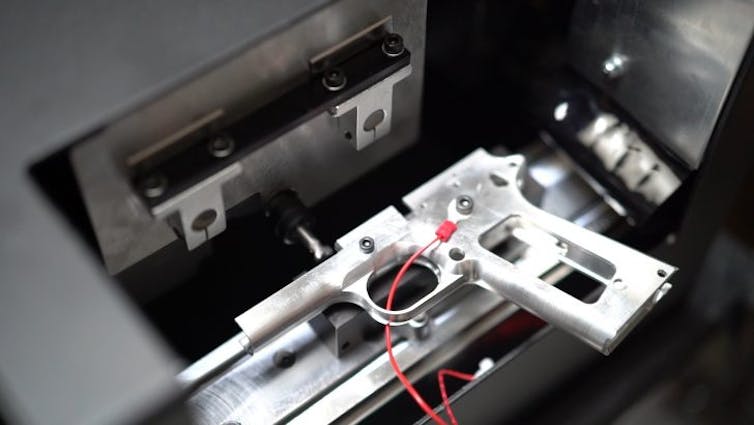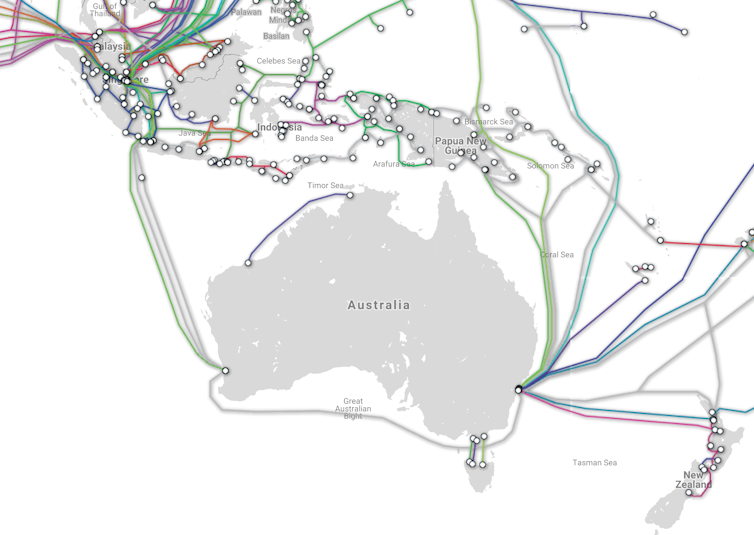US citizens can now publish models of 3D printed firearms online. What does it mean for us?
- Written by Richard Matthews, PhD Candidate and Councillor, University of Adelaide
A landmark case in the United States has been settled out of court, giving gun rights advocate Cody Wilson the right to publish instructions on the web that explain how to 3D print firearms.
The suit was filed by the Second Amendment Foundation on behalf of Wilson and his company, Defense Distributed, which was previously instructed by the US government to remove such blueprints. The company will resume publishing the files at the end of the month.
 The Defence Distributed website now shows a landing page that celebrates the victory over the government stating they will relaunch their file sharing service
Screen Shot 17 July 2018 at 12pm
The Defence Distributed website now shows a landing page that celebrates the victory over the government stating they will relaunch their file sharing service
Screen Shot 17 July 2018 at 12pm
Read more: Explainer: what is 3D printing and what's it for?
Under the settlement, the US Government has acknowledged firearms which are not inherently military – non-automatic firearms up to .50-caliber – will now be exempt from current export controls on the publishing of military data.
Critically, the US government won’t be responding to the case with revised controls. Wilson’s lawyer successfully argued sharing a 3D scan of a firearm on the internet was protected on free speech grounds. From 1 August, instructions for 3D printed firearms can be shared online in America with impunity.
Wilson has suggested in a tweet the settlement signified the death of American gun control. But is it?
3D printed guns are improving
Downloadable instructions for 3D printed firearms become an issue for gun control when those instructions can be turned into an actual gun.
Until recently, 3D printed firearms were made of plastic and looked like toys. But 3D printed guns made from metal parts are now a reality.
At the heart of Wilson’s case is a desktop milling machine called the Ghost Gunner.
 The Ghost Gunner CNC machine is around the size of a large microwave oven and takes unfinished blanks of firearm parts which can then be finished into workable parts at home.
The Ghost Gunner CNC machine is around the size of a large microwave oven and takes unfinished blanks of firearm parts which can then be finished into workable parts at home.
3D printers build up layers in an additive process, but milling machines like the Ghost Gunner carve parts in a subtractive process from a blank. Blanks are blocks of metal resembling half finished critical parts of guns that are shipped for users to finalise on their own machines. Additional parts can then be fabricated using 3D printers and other technologies.
Desktop milling machines are not new. In the open source community they have been available in various forms since the early 2010s. What is critical is they are becoming cheaper, more accessible and easier to use.
This is in part due to educational resources becoming more readily available than they were 12 months ago.
Read more: The legal minefield of 3D printed guns
At the University of Adelaide, we are now teaching formal introductory courses on 3D prototyping. These courses include the basics of how to design for and operate desktop 3D printers, laser cutters and milling machines. Importantly, it also includes modules on ethics to teach students the impact these new tools are having.
New laws aren’t required
In Australia, it is already illegal to manufacture a firearm without a licence. There is no exception to this rule.
There have always been those that will flout the law and attempt to manufacture firearms from everyday items found at local hardware stores.
Advances in technology do not mean we need new laws.
While desktop fabrication methods make it easier for uneducated users to manufacture these items, they would still be breaking the law. The issue then becomes a question of how to identify illegally constructed firearms.
Could this be done via the internet?
Currently, NSW is the only state to have made it illegal to possess files containing 3D models of firearms. Since Australians have no first amendment right to free speech the new ruling has no context here.
The majority of Australia’s internet connectivity is sourced through undersea cables that land in either Sydney or Perth. The internet works by sourcing data via the shortest route from your computer to the server the data is located on. So traffic from the United States typically arrives via Sydney.
But it’s unclear whether the NSW law extends to temporary internet traffic containing 3D models of firearms that are then downloaded in other states or territories.
 The location of the undersea cables which provide the majority of Australia’s internet connectivity to the rest of the world.
Submarine Cable Map, CC BY-NC-SA
The location of the undersea cables which provide the majority of Australia’s internet connectivity to the rest of the world.
Submarine Cable Map, CC BY-NC-SA
New technologies around file sharing could help
A free exchange of firearms legally on the internet comes as no surprise to those who support the free exchange of information. This is one of the principles the internet was founded upon.
Sir Tim Berners-Lee, founder of the World Wide Web, said himself:
The original idea of the web was that it should be a collaborative space where you can communicate through sharing information.
However, not all information should be freely available and shared in this modern age. You have no right to know what is in my bank account.
When I previously wrote on this topic, I called for the remit of an agency such as the Australian Classification Board to be extended to digital files available for sale to the public.
Read more: Proposed new regulations for 3D printed medical devices must go further
But this would do nothing to help block illegal files freely available to download. While the Australian government could censure Defense Distributed by placing it on the Australian Communications and Media Authority blacklist, this would not stop those who genuinely wanted access.
One solution is for researchers to begin exploring technologies that can identify, classify and block files in real time as they travel through the internet. Current technologies exist for tracking items including child exploitation material. While this technology works by matching files stored in databases it’s only a matter of time before technology shifts from passive matching to preventive filtering of content as it is uploaded.
Authors: Richard Matthews, PhD Candidate and Councillor, University of Adelaide





